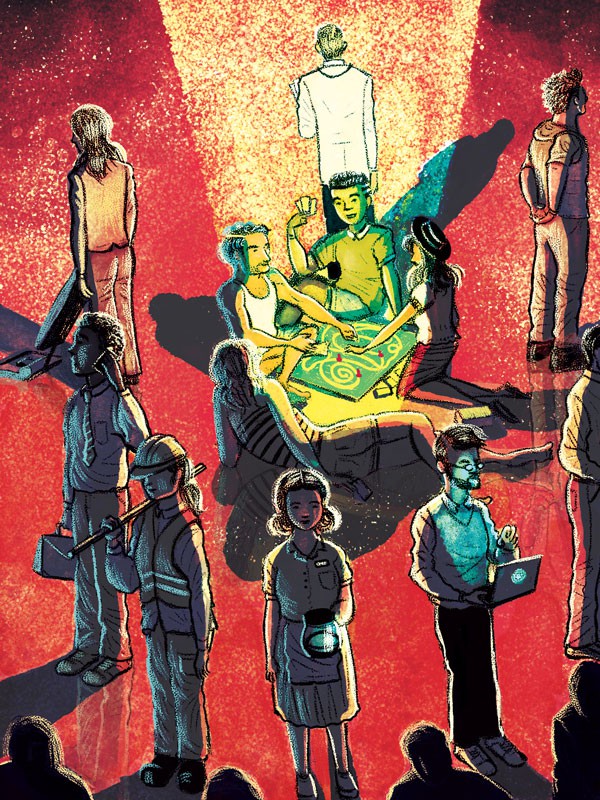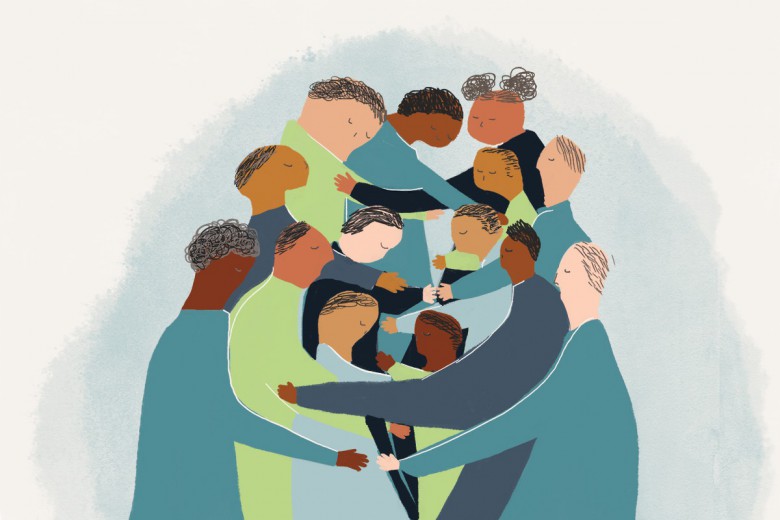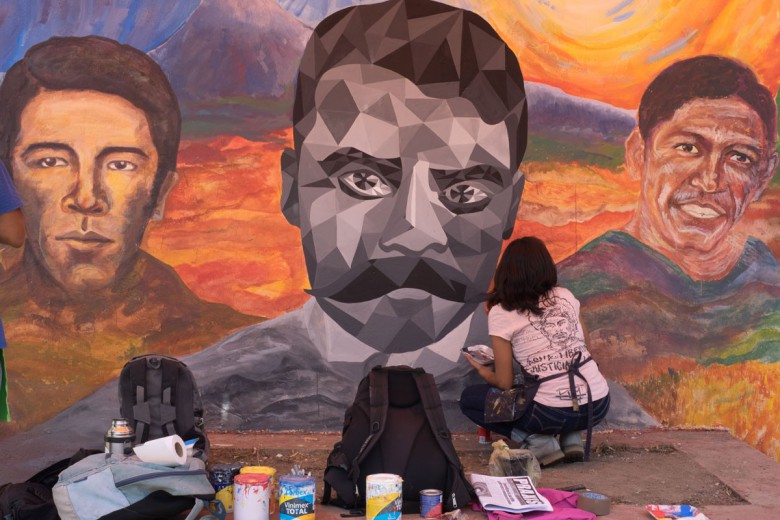
Board games are pretty hip right now – playing them, collecting them, inventing them. A friend tells me that “working on developing a board game” is the new “I have a novel in a drawer” of a certain urban demographic. No longer relegated to cottages and church basements, board games have found new homes and reimaged cultural capital with the emergence of board game cafés. Since the opening of the board game café Snakes & Lattes in 2010, Toronto has seen a boom in the creation of board game cafés and pubs, including Castle Board Game Cafe, Roll Play Café, Café Princess, and Chit-Chat-Play. Other cities have also seen this trend, with cafés like Ottawa’s Monopolatte, Kitchener’s The Adventurers Guild, Winnipeg’s Across the Board, and Edmonton’s Table Top Café.
There is something keenly nostalgic about playing board games. For some players, board games colonized their imaginations long before they were introduced to video games. Board games, especially strategy games like The Settlers of Catan and Monopoly, are reminders of childhood afternoons marked by endless stretches of time to scheme and strategize with friends or siblings over a plate of Oreos. When I visited Snakes & Lattes, game curator Steve Tassie explained that many of the most popular games are children’s games played by adults. Jenga, Connect Four, and Battleship are constant favourites, he explained while gesturing towards a table of 20-something women who were, at that moment, transfixed in a game of Candy Land.
Like books, board games are also portals to other worlds. In the sequel to Alice’s Adventures in Wonderland, In Through the Looking-Glass, Alice plays an animated pawn in a life-size chess game. The most famous cross-platform book/movie/board game is Jumanji. The magic of board games is likewise found in those giant human-sized chessboards and other games you can find at resorts and some especially over-the-top weddings.
One reason we love board games is their tactility. Tassie suggests that the board game and video game relationship is akin to the e-book and book relationship – video games are hugely popular but board games have their enduring appeal. Manipulating little soldier figurines, or tumbling the dice and then decimating your opponent’s field of wheat, is especially satisfying in manual form. While many board games like Snakes & Lattes’ most popular game, Cards Against Humanity, are designed for adult players, board gaming also connects players to the imaginative play of their childhoods. Nostalgia helps fuel the enchantment.
Retro-gamification
Do board game cafés signal a turn away from what many perceive as the solo, anti-social, basement dwelling pastime of video gaming? Gaming expert Jennifer Whitson disagrees with this characterization of video gamers.
“As with comic books,” she says, “there are many moral panics around the role of gaming in our lives. Gaming has always been social. It was only in the ’80s and ’90s where solo play was facilitated by our home computers and consoles. The social play and spectatorship of the public arcades moved into our living rooms. We could then play with machines rather than people.” In fact, Whitson continues, “In the ’90s, LAN parties (bringing your PC to a location and linking it up with your friend’s) were popular. And Internet cafés are extremely popular, especially outside of Europe and North America. Solo play is the exception, not the norm, for video gaming.” Rather than a challenge, then, perhaps board games are just another iteration of an ancient, universal pastime of game playing.
There is perhaps even something transgressive in the idle and unproductive time spent playing games. In her book The Virtual Self, Nora Young, technology expert and CBC radio host, documents how our entire lives have been co-opted by “gamification.” Health is repackaged as a game through the use of Fitbits. Work productivity, bike routes, and spending patterns are obsessively tracked through various digital platforms and cell phone apps. The cumulative effect in this production of quantified selves is the total, minute, and obsessive adoption of the neoliberal logic of personal responsibility. Board games reintroduce games into our lives outside of this totalizing, neoliberal imperative. In fact, playing Last Night on Earth: The Zombie Game for hours midday (as I did as research for this article) might be understood as a challenge to the logic of 24-hour productivity and accountability enacted through apps and gamification.
The Seat of Happiness
Board games are produced and circulated within a broader political economy. The majority of board games are produced by one company, Hasbro, which owns Milton Bradley and Parker Brothers as subsidiaries and produces games as iconic as Sorry!, Trivial Pursuit, and Cranium. When I teach the concept of ideology in my sociology classes, I sometimes have students analyze a board game or game show. What, I ask, are the common social values being endorsed or challenged in this game? Some games are obvious: The Game of Life clearly endorses dominant capitalist social norms.
Board game historians note that the oldest American board game, The Mansion of Happiness, published in Massachusetts in 1832, had quite explicit pedagogic aims. The instructions, written as a poem, read:
At this amusement each will find
A moral to improve the mind:
It gives to those their proper due,
Who various paths of vice pursue,
And show (which vice destruction brings)
That GOOD from every Virtue springs,
Be virtuous then and forward press,
To gain the seat of Happiness
Players advanced by landing on squares marked with virtues, while vices sent them back.
Snakes & Lattes boasts more than 2,000 games of various genres: light strategy, advanced strategy, party games, children’s games, trivia games, and word games. It would be impossible to suggest these games present any clear, uniform ideologies. Tassie argues that the best game is always the game that’s best for the group: fun trumps sophistication, gimmicks, or marketing. However, board game connoisseurs, those who produce value claims about various games, allow us to see some broad patterns in the social values celebrated in board games.
As with video games, militarism, colonialism, and macho masculinity are major themes in the board game universe. According to boardgamegeek.com, in 2014 the top games included Love Letter, Pandemic, The Settlers of Catan, King of Tokyo, and Robinson Crusoe: Adventure on the Cursed Island – all games that celebrate narratives of colonial exploration and macho heroism. The description for Love Letter reads: “All of the eligible young men (and many of the not-so-young) seek to woo the princess of Tempest. Unfortunately, she has locked herself in the palace, and you must rely on others to take your romantic letters to her. Will yours reach her first?”
The gender bias in board games has not gone unnoticed. In 2012, Hasbro faced criticism by a six-year-old Irish girl for having too few female characters in its popular game Guess Who? Her letter launched a social media campaign that focused attention on the gender and racial ideas produced through board games. In 2004, two Canadian women produced a women’s history board game called Eve’s Quest to address this bias. Part trivia, part Cranium-style activities, Eve’s Quest defines cultural capital as knowledge about Mother Goose, Mother Teresa, and Madonna.
Of course, there is always the less ideologically fraught Jenga.
Unplugged Cafés
Board game cafés offer a revitalized sense of how to play in quasi-public spaces. Many people have bemoaned the decline of the café as social space, blaming both chain ownership of cafés (ahem, Starbucks) and laptop labourers. With their clear purpose, board game cafés re-establish the café as a public, social space. Snakes & Lattes has adopted a clear no Wi-Fi policy for this reason. Of course, board game cafés are not public spaces, they are private spaces, and players pay for their drinks, snacks, and the right to play. Snakes & Lattes has a $5/gamer flat rate, while other board game cafés charge by the hour.
However, in a society that Robert Putnam describes as marked by a condition of “bowling alone,” perhaps idle togetherness, even in the context of some ideologically fraught games, offers a social salve for the woes of urban alienation.






